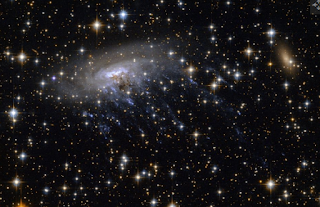The universe contains some place in the ballpark of 100 billion and 200 billion worlds. With numbers that huge, you can wager that there are some genuine weirdos out there. Out past our Milky Way, there are galaxies formed like jellyfish, worlds that devour different worlds, and worlds that appear to come up short on the dull issue that plagues the remainder of the universe.
Here are the absolute most interesting worlds out there.
1. Much the same as a jellyfish
Situated in the heavenly body Triangulum Australe, galaxy ESO 137-001 looks incredibly like a jellyfish swimming in the midst of an ocean of stars. The galaxy is a banished winding world — together, its stars structure a twisting shape with a bar-molded focus — with a curve: decorations of stars that appear to float like jellyfish limbs.
As per NASA, these stars are shaping inside a tail of residue and gas (imperceptible to the unaided eye) that streams off ESO 137-001. This arrangement cycle is somewhat of a secret, as the gases in the tail should be excessively hot for star development.
2. Missing matter?
In 2018, the Hubble Space Telescope spied something never observed: a world with basically no dim issue.
This disclosure quickly raised warnings. Dim issue is a baffling type of issue that connects with gravity, however not with light. It makes up a greater amount of the absolute issue known to man than the issue we can see, so finding a universe with no was peculiar, without a doubt.
After a year, logical investigators tackled the secret: The galaxy, NGC 1052-DF2, was not 65 million light-years away, as initially accepted. It's truly just around 42 million light-years away, scientists revealed March 14, 2019, in the diary Monthly Notices of the Royal Astronomical Society. That adjustment in distance totally modifies the computations for the galaxy's mass. Ends up, it's a pretty typical galaxy all things considered, and the universe (sort of) bodes well once more.
3. Zombie Galaxy
The gigantic, circle molded universe MACS 2129-1 twists twice as quick as the Milky Way does, however it's as yet not close to as dynamic. Hubble perceptions of the inaccessible world uncover that it hasn't made stars for approximately 10 billion years.
Macintoshes 2129-1 is the thing that's known as a "dead world," since stars at this point don't frame there. The disclosure of this galaxy was a head-scratcher. Researchers accepted that galaxies of this sort had framed by converging with more modest universes over the long run, however MACS 2129-1's stars didn't shape from such a dangerous consolidations; they shaped almost immediately, in the circle of the first world. The discoveries, distributed in the diary Nature in 2017, propose that dead universes by one way or another inside modify their structure as they age as opposed to changing shape since they join with different galaxies.
4. Barbarian world
As though zombie worlds weren't sufficiently creepy, a few galaxy are goliath savages. The Andromeda universe, Earth's biggest neighbor, has been eating up more modest galaxies for at any rate 10 billion years, as indicated by 2019 exploration. In another 4.5 billion years, the Andromeda world and the Milky Way galaxy will impact, in spite of the fact that it's not yet clear who will eat up whom in that astronomical heap up. (Earthlings, sadly, won't be around to see this conflict happen, as our own sun is warming up and will probably make life on Earth inconceivable between around 1 billion and 5 billion years from now.)
5. Fledgling swims through space
300,000,000 light-years away, a gigantic fledgling swims through space. This "fledgling" galaxy has a tail that is an incredible 500,000 light-years long, and is multiple times longer than the Milky Way.
What made this odd galactic shape? A grandiose crash, analysts detailed in 2018 in the diary Monthly Notices of the Royal Astronomical Society. Two plate galaxies pulled on a more modest bantam world, clustering the stars toward one side into a "head" and forgetting about the others to stream in a long "tail." This course of action is temporarily just, however. In two or three billion years, the galaxies will combine with some others in the region to make one single world.











No comments:
Post a Comment